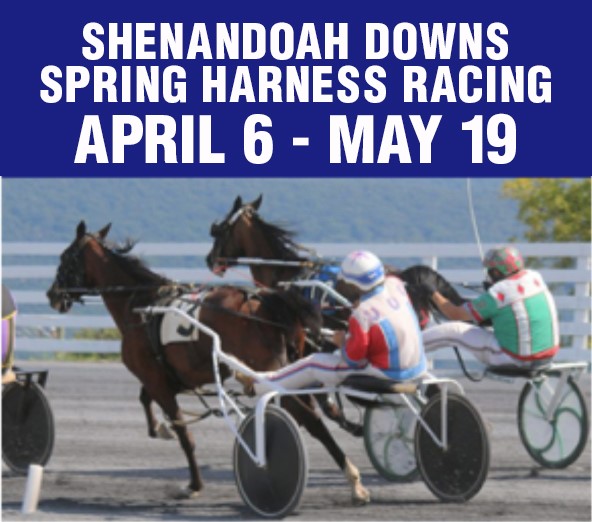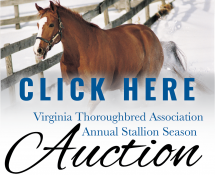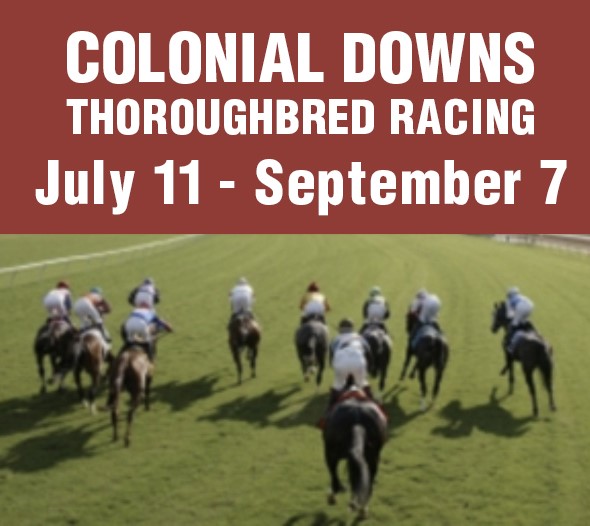Article from www.pressboxonline.com. Jockey Edgar Prado won several riding titles at Colonial Downs and won the Virginia Derby three times. That stakes race was held at Colonial Downs from 1998-2013. It has been renamed the Commonwealth Derby, is a Grade 2 stakes, and will highlight a Virginia-bred and Virginia-themed afternoon of turf races this Saturday, September 24th at Maryland’s Laurel Park.
On a sweltering August day, the Hall of Fame jockey comes in early, as usual. Twilight racing at Laurel Park doesn’t start for another 90 minutes, and Edgar Prado is doing what the best at a trade do as their own competitive days dwindle: He teaches.
“You have to stay tight to the horse, like you’re part of it,” Prado said to Forrest Boyce, a regular on the Maryland circuit for several years, as she hunkers down on a rocking horse that is about a quarter the size of an actual thoroughbred. Like others here in the jockey room, Boyce knows to defer to experience. Boyce conforms her body to the faux horse, forming a seal around it. “Yeah, that’s it,” her mentor encourages.
“I teach them that instead of it being you and the horse that they have to be a unit, be one,” Prado said.
Prado, 49, has been one with horses his entire life, riding as a young boy and as a teen jockey in his native Peru. He came to Florida to ride in the mid 1980s, still a teenager, then moved on to Massachusetts where his aggressive style of navigating horses through traffic ran afoul of track stewards.
Bob Klesaris, the trainer who had shepherded Prado north, took him aside and told him, “I’ve got good news. The stewards won’t bother you anymore.”
“He hugged me,” said Klesaris, now Prado’s agent. Then, Prado asked Klesaris where he’d be riding next. Told he was heading to Maryland, Prado asked, “What country is that in?”
Prado would come to own the state he once couldn’t finger on a map. Almost from his arrival on the Pimlico Race Course/Laurel Park circuit in 1989, his late-riding, ground-saving style dominated. His photographic memory tags Lone Allure, a Klesaris-trained horse, as his first mount here. It won, paying $42 on a $2 bet, Prado said.
By the end of 1997, he had racked up 3,000 winning mounts, spending six years as the state’s leading jockey. At his peak at Laurel Park, Prado earned $8 million for owners and trainers. Jockeys get 10 percent of the purses they win with their agents getting a portion. In 1997, he became the fourth all-time jockey in the nation to win 500 races in a year.
“Those were great times,” Prado said. “I did well for so many years, and my family did well here. They loved it. We took vacations during the Timonium meet [in late August/early September]. It was perfect.”
And yet, after guiding more than 400 horses to the winner’s circle, Prado followed the money and the lure of better horses to New York, where he competed against several Hall of Fame jocks, including Jerry Bailey, Jose Santos and Jorge Velasquez.
Some gratifying triumphs and one devastating ride in Triple Crown races followed.
Returning Home
The tally tells much of his story: 36,000 mounts and just short of 7,000 wins, including one in the Kentucky Derby, two in the Belmont Stakes and four in the Breeders’ Cup. He was elected to the U.S. Racing Hall of Fame in 2008.
Now, for the first time since 1999, he’s back. With some modest fanfare, Prado returned to the Maryland circuit in May to ride at Pimlico, where he won a little less than his career average — about 17 percent of his races — highlighted by a 27-percent mark during the short Laurel summer meet.
For young jockeys, such numbers would be a sign of a career on the ascent, and perhaps a rich future steering 1,200-pound beasts around an oval and in, out and in between other 1,200-pound beasts. For Prado, not so much. He’ll be 50 next June and riders rarely make it that long in this fiercely competitive game. The finish line is in sight.
“Edgar is in the twilight of his career,” Klesaris said. “It’s unfortunate. He’s done everything he can to get where he is and to hang on. He runs and exercises every day, watches what he eats. He trains like a boxer, something you don’t see from the younger guys.”
Back in the day, Prado would ride in eight or nine races, sometimes seven days a week. Now, he averages about three rides a day. To keep his dance card full, he drives or flies elsewhere — Arlington Park in Illinois; Delaware Park; Monmouth Park in New Jersey; Penn National and Philadelphia Park in Pennsylvania; Woodbine in Toronto; and Saratoga in New York — often just to ride one race for Hall of Fame trainers, such as Shug McGaughey or Kentucky Derby-winning Maryland trainer Graham Motion.
“If you have one horse in one race for the money, you want Edgar up,” Klesaris said. “Eight horses in a day? Not anymore.”
But being able to win that one race means quite a bit.
Motion, the trainer who won the 2011 Derby with Animal Kingdom, added: “That he can still ride this competitively at his age speaks volumes about him. He’s the definition of what a jockey should be: very smart, with great hands and a sense for horses. Being a jockey means being able to see what will be happening seconds from now, essentially to see a bit into the future. He’s an expert at that.”
After leaving Maryland following the 1999 season, Prado won his first two Triple Crown races at the Belmont Stakes in New York in 2002 and 2004. The first was with Sarava and then aboard Birdstone in a dramatic upset of Smarty Jones, foiling a Triple Crown bid.
Prado’s most memorable win was in 2006, when he guided the legendary Barbaro to a stirring 6.5-length win in the Kentucky Derby. However, Prado may be best remembered for a ride he never finished: the 2006 Preakness Stakes when Barbaro shattered his right hind leg just after leaving the starting gate at Pimlico.
Prado managed to bring the crippled Barbaro to a stop and calm the bay colt until help arrived. In doing so, Prado is credited with giving Barbaro a fighting chance to survive the injury before the beloved colt eventually succumbed to laminitis in January 2007.
The experience, including Barbaro’s months-long battle to overcome the injury, had a profound effect on Prado. A few years later, he wrote of his time with the remarkable colt in a book co-authored with John Eisenberg titled “My Guy Barbaro: A Jockey’s Journey Through Love, Triumph, and Heartbreak.”
In the last two years while based in Florida, Prado suffered his own tumbles, spills and wayward mounts that put him on the shelf for months at a time. Despite the injuries, he claims he is as competitive as ever.
“I’m still fearless, still aggressive,” he said. “If you’re not fearless in this business, you should get out.”
But other jockeys who have faced the same obstacles say the broken bones and concussions will eventually take their toll on him, as they do for everyone.
“You reach a point where you say, ‘I just don’t want to hit the deck again,'” said Chris McCarron, like Prado, a Hall of Famer and former Maryland racing champion. McCarron retired at 47, not only concerned about his health but the quieting of the fires that once defined him.
“It became harder for me to prove to myself that, on a daily and weekly basis, I still had the desire to go at it with young riders,” he said. “I was satiated with it.”
Prado said he won’t stop until he has to. The way he lives his life shows a stalwart’s dedication to task. He rents a place in Mount Washington, using Baltimore as a base of operation from which he can travel more easily to tracks elsewhere. He sees his wife and three grown kids in Florida about five days a month.
Humble To A Fault
Prado’s commitment to his sinewy, powerful body is intense. He still weighs about 110 pounds, same as 20 years ago, eats the same paltry amounts of food, takes the same vitamins and supplements. When he’s racing at Laurel or Pimlico during non-summer meets with earlier post times, he hits the track before rush hour to ride his future mounts and help out trainers.
“I will never say no to work,” he said.
Those who have known him say his drive comes from a youth spent in the Lima suburb of La Victoria, not far from the shimmering Pacific shore, but more than a few furlongs away from prosperity. His early life, spent with 12 other family members in five shared rooms, was defined by horses and hardship.
Jose, his father, made what he could as an exercise rider at Hipodromo de Monterrico, the track 30 minutes from home where Edgar and two of his brothers, Jorge and Anibal, broke into the rider’s trade. Jose taught his sons to respect animals.
“He told me always to be careful,” Prado said in a 1998 interview. “You could never know what they’d do. He let me know that it was important to make the horse feel calm with you, to make him feel confident.”
Edgar started as an exercise boy at age 14 and debuted as a jockey not long after. In doing so, he disappointed his mother, Zenaida, who wanted her bookish youngest son — he aspired to becoming a lawyer — to finish school. His first mount, Enmascarada (“Masked,” in English), came in dead last.
But by the time he turned 16, he was the leading thoroughbred jockey in Peru. A sponge for knowledge, he listened to advice from trainers and his father, who taught him how to read a horse, its nerves and its ability to “listen” to a jockey’s signals.
A friend in Lima invited Prado to his home to watch the Kentucky Derby and the inaugural Breeders’ Cup races.
“He started dreaming then,” said Liliana Prado, Edgar’s wife of 30 years.
He had met Liliana, a girl from another racing family, when the two were 17. They married once Edgar decided to chase that dream to Florida, even though he hadn’t heeded his brothers’ advice to learn English. He knew nary a word of it.
Prado was hardly an instant success. His days at the track at Hialeah, which is near Miami, were long and often winless. Much of his meager earnings went to pay an immigration attorney. Barely making it, he flopped at a friend’s house in Miami Beach, taking the bus to the track — 90 minutes each way.
Friends and collaborators said those early years before Klesaris arrived formed much of his stateside personality: steely, but humble to a fault, calm, generous, indefatigable.
Those traits would serve him well when he became accomplished enough to be ranked among the top five jockeys in the country while based in New York during the 2000s. There were moments that required him to be grounded and modest, like after he shocked the thoroughbred world by leading Sarava, a 70-to-1 longshot, from well off the pace to the Belmont Stakes winner’s circle in 2002.
Prado was gracious, even apologetic, after disappointing most race fans as he guided Birdstone past Smarty Jones in the homestretch of the 2004 Belmont.
There were also trials that forced him to stay cool and focused, like when Barbaro, the favorite at the 2006 Preakness, broke down in the opening stretch. Millions of TV viewers watched as Prado slowed the injured horse, dismounted, patted and calmed the Kentucky Derby winner, whose right rear leg had shattered in 20 places. Prado quieted the horse while leaning against its shoulder to support some of its weight.
“We were looking to win a Triple Crown,” Prado said. “I just wanted to bring joy and happiness to Maryland. It had been such a good home to me for so long. I was also trying to get some relief from dealing with the death of my mother a few months before. I’ve ridden 35,000 horses, and how many have broken down on the opening stretch? One.”
Though it was the low point of Prado’s career — “It was devastating,” he said — the breakdown of Barbaro, who died months later after several surgical attempts to save him, gave the nation more than a glimpse of his character, those who know him say.
“That was really tough for him, but everyone saw [how] he handled the horse, how he took it,” Klesaris said.
‘He’s One Of Us’
These days, the Barbaro heartbreak seems more distant. The Preakness is more popular than ever. Maryland racing has mostly recovered from the small fields, declining purses and dwindling handles of that era, and Prado has returned to run regularly. It’s the Rollicking 1990s all over again.
Except for one difference: Instead of being a young jock on the upswing, Prado resembles a retiring baseball player on a farewell tour. His return is partly responsible for a 20 percent bump in Laurel’s handle — the total amount wagered — this summer.
“The handle and attendance at the Laurel summer meet got its start at Pimlico this spring when Edgar came back,” said Stan Salter, a racing analyst for the Maryland Jockey Club, which operates Laurel Park, Pimlico Race Course and the Preakness Stakes for parent company, The Stronach Group. “Obviously, a lot of that is due to the Preakness, but you can give some credit to Prado. Anytime you have a Hall of Famer listed in your early entries, it bumps up interest.”
Fans relate to Prado’s humble-yet-hard-driving image. They may be at the track to win, but Salter said they appreciate the people and animals that compete each day. And they remember.
“I’ve been watching him for years,” said Jorge Falu of Catonsville, Md., a Laurel Park railbird who had just won his money back by boxing a trifecta, including a Prado-ridden mount that finished third. “Everybody’s really happy to see him come back. He’s one of us.”
Prado said he enjoys being remembered and reliving some of his glory years.
“He told me he’s really happy to be there,” Liliana Prado said. “He’s got a lot of good memories.”
Though he still wins his share of races, it hasn’t come easy. While Motion continues to put Prado atop his horses, other trainers have remained loyal to the younger guys they’ve been using during Prado’s absence.
Strangely, some trainers believe Prado has something left to prove.
“When Edgar wins, people say, ‘He’s supposed to win.’ If he doesn’t, it’s ‘He’s had it,'” Klesaris said.
That kind of thinking, along with an incredibly strong clutch of young riders on the New York circuit, forced Prado to take 8-1 and 10-1 mounts, instead of the 2-1 and 3-1 ones he had become used to.
“We couldn’t make it on that,” Klesaris said.
Prado’s return might have set off alarm bells from jockeys here who had reason to worry he’d hop on top of all the best horses. Back in his Maryland heyday, Prado caused more than a few jocks to gripe. (“Prado’s all right, but he gets all the good mounts,” Greg Hutton said in 1998, citing Prado’s stranglehold on the best trainers and horses.)
But that hasn’t happened yet. Prado learns every jockey’s name and offers advice whenever he is asked. He’s more a gray eminence than a dark threat.
“Everybody looks at him like a daddy,” said Alex Cintron, a Maryland circuit mainstay for the past five years. “When you ride against a great rider like him, you appreciate the safety that comes with it. Of course, when you beat him, you feel really, really good.”
“I have three words to describe Edgar: class, class and class,” added Feargal Lynch, a rider from Derry, Northern Ireland, and one of the win leaders among summer meet jocks. “He’s a great guy to work with. He’s not the type to push you off a horse. And he’s always willing to share his thoughts on racing with you.”
Soon enough, thoughts and memories of horse racing are all Prado will have. Those around him understand this.
“Every year he says, ‘I’ll ride two more years,’ and I just laugh,” Liliana said. “He doesn’t heal as fast as he used to. That’s the only real concern for me. I hope he retires soon. Riding carries too much risk.”
The next chapter will involve some travel and considerable blocks of time watching his favorite shows on the History or Discovery channels.
“I’d like to relax for a while,” he said.
But the chapter after that — after he realizes he misses the track — beckons, too. He doesn’t have enough money to be a horse owner, he says, and he has little interest in training horses.
Becoming his one-time nemesis — a steward, a race official who watches for jockey infractions — appeals to him. Klesaris said he can envision Prado as an advisor to racing syndicates as they buy thoroughbred ponies.
“His connections among owners and trainers are second-to-none,” he said. “I’ve never seen a rider who can pick out the best horse in a barn just by sight the way Edgar can.”
But in the meantime, Prado is enjoying himself too much to stop riding. He’ll postpone the inevitable for as long as he can.
“This is definitely a satisfying time for me,” Prado said. “I try to define myself by whether I’m working and whether I’m giving it my all. I love horse racing so much. I don’t have that much left to prove, but this is what I love to do, and I’ll keep doing it for as long as I can.”







